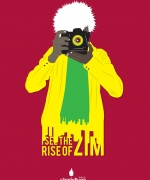Design Education in Zimbabwe 1980 - 2000
Design education in Zimbabwe is the nucleus for the development of design in Zimbabwe. The more educated the community and designers are the higher the level of appreciation and value placed on design. In this chapter we take a look at the development of design education in Zimbabwe and where it is going. For my information on design education I was referred to Anthony Mellon who’s been very influential in the graphic design in Zimbabwe. We will see the important role he played. Mellon was a lecturer at Bulawayo Polytechnic College teaching design in the late 60’s. During the 50’s-70’s era designers studied in South African colleges mostly Natal Tech. Other people started their own private colleges, though they were very small for example, Jim Spence and Peter Birch.
HARARE POLYTECHNIC
After having moved to the Harare Polytechnic Printing Department in 1974, he saw the need for graphic design course at the college. He felt the course at Bulawayo Tech was not up to international standards. In 1978 h wrote a letter to the Minister of Higher Education emphasising the need for a graphic design course. 1979 the proposal was accepted by Minister Ushewokunze (late) who was then the Minister of Higher Education.
The Graphic Arts Department was opened at the Harare Polytechnic College in 1980. The criterion was 5 O’Levels and a portfolio of your most recent work, exemption being given to people with degrees. The Poly offers a three-year programme. First year is a National Certificate in Applied Art and Design which consists of the following subjects, Art Appreciation, Basic Design, Art and Design, Lettering, Ornamental Design and Creative Studies (3D Studies-Ceramics, Textiles and Printmaking). After this students have a choice to either pursue a two-year Fine Art or Design for Print Diploma. The design for print programme includes Layout, Illustration, Packaging, Typography, Project, History of Art, Photography and Graphics. Students are also introduced to computers at this stage.
The Poly places high emphasis on creativity. It also crosses the boundary into product design as well. There were two full time lecturers, Mrs Kirkman and Anthony Mellon, and four part-timers, Di Duedney, Thakor Patel, Martin van der Spy and Ian La Mond, all who were well renowned artists and designers. In its first year there were 12 full-time and 50 part-time students. The full-time students were predominantly white with the sex ratio generally even and the part-timers were predominantly black with much more males. For one holiday Mellon organised industrial training for students to get a hand of the industry. At this time there were no computers in the department. Mellon left Harare Polytechnic in 1987 giving way to Mrs Curling who went on to start a Fine Art programme in 1987, as the department grew bigger. At this time the college did not face too many problems because with the emphasis on development of the new country Zimbabwe. The government was very supportive and the college was running smoothly to the extent that each year the second years went to Mana Pools for a week attending lecturers, drawing, painting and canoeing! The 90’s brought about change with Fine arts contending with the design programme. In the early 90’s most design lecturers left the teaching profession and went into the design industry. Jane Shepard came to Polytechnic from England in 1989. She was on a full time basis.
Throughout the 90’s the Poly has seen some major changes. First the changes were positive with the donation of three Apple Macintosh computers, with relevant programmes, printers, a scanner and even a photocopier. But due to the deteriorating economy design lecturers opted for the industry over teaching where the pay was much higher. This had an effect on the students. The department which was more for graphic design became more inclined to the fine arts. I remember a time during 1999 where there was no design lecturers at all, we were getting no formal education for over a month and a half. But things began looking up with the arrival of volunteer part-time lecturers and a full-time lecturer. At the present moment the Poly is producing an average of about 15 designers each year. The number is kept at a minimum because of lack of resources. With tuition fee subsidised by government, education was much cheaper. This in turn meant lots of people were applying for places. On average there are about 100 people vying for 20 – 25 places! This had resulted in the portfolios becoming very competitive. But again this might be changing with tuition fess being raised to $3000 from $100! I have a feeling the enrolment criterion is going to drop and it will cater for those who can afford it, and eventually lower design standards and lose all the hard work achieved over the past two decades. ZIVA (Zimbabwe Institute of the Vigital Arts) ZIVA (also a Shona name which means “Knowledge”) is a New Media Arts School. ‘Vigital’ is a word coined by the founder Saki Mafundikwa, to best describe the school “training students in the visual arts using digital tools”. Saki who left the country during brain drain of the 70’s returned after an absence which totalled 20 years. He was educated in the United States. He spent 12 years as an Art Director in New York; advertising, graphic design, publishing and New Media. He had 3 years teaching experience and had lectured widely about design in the US, UK, Africa, South America and is Chairperson of Graphic Association of Zimbabwe (GRAZI). Saki came back with a new vision to spread the design word in Zimbabwe. ZIVA opened its doors on February1, 1999 with only four students! Currently there has been no enrolment criteria because the college is still small, emphasis is on encouraging prospective students. Hopefully as demand for the course increases it will be necessary to screen applicants probably on their academic and creative skills. Enrolment has been average, 10 full time students, because of the same reason as above. As the college develops a reputation and can offer scholarships, the enrolment will increase. There are two full time and three part time lecturers. ZIVA also has lecturers who visit from out of the country and lecture. Emphasis on the changing face of design which now includes multi media (internet, web design, videos). ZIVA aims to ‘amaze and shock the world with our new output as we cart new ground and breakdown old stereotypes about our vibrant and highly creative continent’. I feel that ZIVA’s mission and aims are exactly what Zimbabwe design education needs. But I don’t think these aims will be achieved anytime soon. Firstly the enrolment criterion has to change and focus on design-oriented students. Once students start competing for places the standards will rise. But it takes time and I feel if the faculty at ZIVA remains passionate about their aims they will be achieved. At the moment ZIVA is playing a crucial role in furthering the education of designers already in the industry. Keeping them up to date with technology.
PROBLEMS FACED BY STUDENTS
Talking to some design students, we discussed some of the problems faced by design students. Below are some of the problems most of the students agreed were hindering or lacking in their education:
Experimentation: Students are always encouraged to experiment while in college. But most students feel reluctant to because marks go toward the course work mark at the end of the programme. So they stay on the safe side they stick to conventional designs which they know will pass. They however suggested that if the programme was lengthened to four years they could have more chances to experiment. Introduction of a degree programme was also suggested. Considering that most of the major innovations in design in Europe were done by students or faculty universities e.g., Bauhaus. I think a degree programme in Zimbabwe would give students a chance to forget about marks and aim for experimentation and creative freedom.
Lack Of Talks: Students also expressed a hunger for talks from designers in the industry. Especially at the Polytechnic students felt that they were a bit neglected considering that these same students are the ones who will be working for those same companies. Things are starting to look up as lectures are being organised with students going to advertising agencies for lectures.
Lack Of Resources: Learning conditions at the Polytechnic were very trying for the students, with the college constantly being closed because of demonstrations, college politics, lack of resources (three computers between 15-20 students!). But this lack of resources I must note has brought the students to cooperate with each other and find solutions to work faster under pressure with terrible conditions. Having produced exceptionally good work under these condition I believe things can only get better.
Course Title: Students and other concerned people pointed out that the course title design for print had to be changed because it was becoming obsolete with the introduction of web design which will never be seen as print. Alternatives were either simply Diploma in Graphic Design or Diploma in Multi Media Design. The current title will not be marketable in the next decade or less. Apparently, the course was a City and Guilds course but the lecturers changed it to become a local exam, probably at the expense of the students.
Student Union: An observation I made was that, to get the best results and make major strides all design students in Zimbabwe must come together as often as possible and work together. In particular the Polytechnic and ZIVA must work together. ZIVA has the resources and the Polytechnic has the space, together they can hold workshop and exhibitions and even do talks and projects together. Instead of competing (although competition is good) and looking down on each other, they can work together and achieve outstanding results. Most problems seemed to come from the Polytechnic student body but I also sent a questionnaire to ZIVA students but they didn’t have many pressing problems. Maybe it is because ZIVA is still small and can cater effectively for the small student body.
SURVEY
I carried out a survey with 30 students, 20 from Harare Polytechnic and 10 from ZIVA. I was enquiring about what they wanted to do after they finished their respective courses. The following five professions were the most popular in order of preference, Design Studio, Web Design, Animation, Advertising Agency and Illustration.
Design Studio 40%
2.
Web Design 27%
3.
Animation House 22%
4.
Advertising Agencies 7%
5.
Illustrations 4%
The figures represent where students would ideally like to work. And I found it quite interesting. It seems most of the students wanted to pursue design in design studios and web design houses and also pursue animation. But the sad reality here in Zimbabwe is that 90% of all these students will be working in the advertising agencies. This is because of the limited number of design studios and web design houses and as for animation they would have to leave the country to fully explore this genre. Advertising ranked very low because students felt that most advertising agencies were filled with older generations who were not open to new ideas and hence depriving them a chance to explore their creativity, but this can be argued that the clients are to blame for this. A few were more determined to explore illustration as they felt some of the illustration in books was below par. As for design studios there seems to be only one really established design house in Zimbabwe, Danes Design. They seem to take only the most promising designers. I feel thought that advertising agencies tend to pay more so designers are willing to sacrifice their talent for more money, a logical solution in this harsh economic climate but it leaves the future of our design in a comprising position. Currently, qualified designers who leave college are absorbed by the industry. This is having a profound effect on the standard of design in college. Students I still feel should be producing some of the best work because they are not too inhibited and have lots of space to experiment. The fact that jobs are almost guaranteed, students have become complacent and are producing mediocre work and settling for just a pass. They are not exploring their full potential. I feel the industry is also to blame because they place more emphasis on computer literacy than on design skills. The first questions they ask is ‘what have you done on the computer” or “Which programmes do you use”. I feel what is essential is design skills, a person can always learn different programmes on the job.
Continue Reading
Development of Graphic Design in Zimbabwe (1980 - 2000)
Design in Zimbabwe - Brief History Of Zimbabwe
Design Education in Zimbabwe 1980 - 2000
Development of Graphic Design in Zimbabwe (1980 - 2000) - Interviews & Stats
Development of Graphic Design in Zimbabwe (1980 - 2000) - Conclusion





